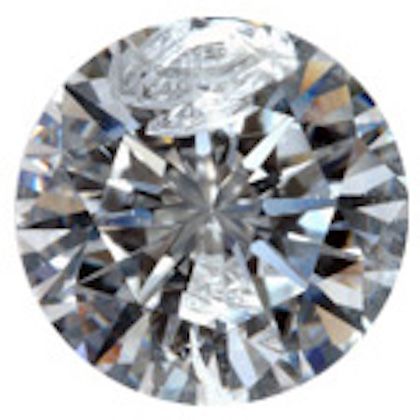How to Buy a Diamond: The Ultimate Guide

So you’ve decided to buy a diamond. Perhaps you’ve decided to propose to the love of your life, or maybe you want to commemorate a special anniversary with your significant other. You want to profess your deep affection and appreciation for your beloved and you want it to come across loud and clear. You are looking for a diamond that is big and beautiful, yet doesn’t break the bank.
You’ve started to look around at different diamonds but got lost in the maze. A vast world opens up before your eyes. Hundreds of thousands of diamonds. So many options! You see new terminology is thrown around you: cut, fluorescence, table, pavilion, crown, fire, brilliance. Your head is spinning. How do you make sense of all this new information? You see similar-looking diamonds going for vastly different prices. How are they different? How do you create order out of all this chaos and how do you decide what diamond is right for you and your loved one?
Relax! You’ve come to the right place. In this guide, you will find a high-level overview of all the terminology you will ever need to understand the important qualities of your diamond. We will also provide you with the best tips to help you make an informed decision. Buying a diamond should be an exciting and enjoyable experience. And it will be once you’ve read this guide.
The Most Important Advice You’ll Ever Get
When shopping for a diamond, it’s very easy to get lost in the technical details and start looking at your diamond as a checklist of qualities. As you try to hunt down the diamond that has the best rankings on your charts, you might start agonizing over whether you should buy a beautiful 1-carat F color diamond for $5,427 or an equally beautiful 1-carat G color diamond for $5,309. Looking at your diamond chart, you can see that an F color diamond ranks higher than a G color diamond. So is it worth spending the extra 100 bucks for the higher quality diamond?
To find the answer to your question, ask yourself two simple questions: Why is the first diamond more expensive than the second? And more importantly, what are you looking for in a diamond?
The answer to the first question is simple. Diamond prices, like all other assets’ prices, are influenced by supply and demand. The rarer the diamond (the smaller the supply), the more expensive the diamond will be.
If you think about the second question for a moment, you’ll find the answer equally simple. Unless you’re an investor, you’re not looking for a rare diamond. You are looking to find a diamond that will most impress your spouse or loved one. Now, I’m pretty sure your spouse didn’t tell you, ‘I’d like a 1.5 carat D color Ideal cut flawless diamond’ (If she did, throw away this guide and start saving up :)). In fact, like most people, they probably don’t know much about diamond terminology. All they know is they would like a big, clear, sparkly diamond.
Coming back to your original question, you should now be able to make a more informed decision. Although you might not know this yet (unless you’ve read this guide before), the F color and G color diamond will appear virtually indistinguishable to you and your spouse. In fact, even trained gemologists will have a hard time telling them apart. Therefore, you should get the G color diamond and pocket the difference.
In summary, never lose sight of what’s important to you and your spouse in finding a diamond. Don’t let your decision be influenced by some technical numbers. Focus on getting the best diamond that maximizes the size, whiteness, cleanliness and sparkliness of your diamond to your eye, not to your list. Read this guide to find out how the different qualities of the diamond affect these attributes and don’t be afraid to get a better-priced diamond that gives you all the qualities you need.
The 4 Cs of Diamonds
Every diamond can be succinctly described in four words: Carat, Color, Clarity, and Cut. Those four words, also known as the 4 Cs, will tell you almost everything you need to know about the diamond. They will also be responsible for the cost of your diamond. Learn them well and you will be well on your road to becoming an educated consumer.
Let’s take a quick overview of the 4 Cs and what they will tell you about your diamond. Carat will tell you how big or small your diamond is. Color will tell you how white or yellowish your diamond looks. Clarity will tell you if your diamond is clean or full of blemishes and imperfections. And last but not least, Cut will tell you how brilliant and sparkly your diamond is or how dead and lifeless it appears.
Carat
A diamond’s weight is measured in carats. Most of us are used to weighing objects in pounds or kilograms, but diamonds weigh very little and so they need a smaller unit of weight. A carat is only 200 milligrams and is therefore perfect for measuring the weight of diamonds. In fact, a 1-carat diamond weighs less than a paperclip.
When dealing with diamonds smaller than a carat, it is useful to divide a carat into 100 points. Thus a 0.5-carat diamond can be described as weighing 50 points and jewelers will often refer to them as ‘fifty pointers’.
Generally, the bigger the diamond, the more expensive it will be. However, since the price is affected by other qualities as well, you can find bigger diamonds that are cheaper than their smaller counterparts. If getting a big diamond is important to you, you might be able to squeeze it into your budget by sacrificing some of the other 3 Cs.
Explore the 4 C's of diamonds.
Pro tip: buy shy
A diamond’s price doesn’t increase linearly with its weight. In other words, a 2-carat diamond will not cost twice as much as a 1-carat diamond, but much more. Since not only is a 2-carat diamond twice as big as a 1-carat diamond, but it’s also much rarer, therefore its price increases exponentially.
If you take a diamond’s price and divide it by its carat weight, you will get its price per carat. Generally, a diamond’s price per carat will stay the same within a range. For example, if a diamond’s price per carat is $500, then a 1-carat diamond will cost $500 (1 x $500), while a 1.15-carat diamond will cost $575 (1.15 x $500). However, at certain points, the price per carat will increase. Those carat sizes where there is a jump in price per carat are sometimes called magic sizes because the price magically jumps.
Some magic sizes are 0.5 carats, 0.75 carats, and 1 carat. Because people prefer to buy those sizes, sellers take advantage and increase the price. Just like when shopping in the grocery store, people would rather buy a product for 5.99 than for 6.00 because 5 is less than 6, people would rather buy a 1-carat diamond than a 0.98-carat diamond because 1 is bigger than 0.
However, savvy buyers can take advantage of this and get a great deal by getting a diamond just shy of those magic numbers. For example, if you find a 0.95-carat diamond or even the rarer 0.99-carat diamond, you would get a better price than for a comparable 1-carat diamond. More importantly, visually the diamond would look like a 1-carat diamond since a diamond would have to have at least a 10% increase in carat weight before there is any discernible difference. Keep that in mind.
Visual Carat
Wait, isn't carat a measure of weight? I thought it tells you how big the diamond is. Well, you have been lied to. A carat tells you how heavy your diamond is, not how big it looks. In order to see how big your diamond looks, you need to look at the dimensions. A diamond has three dimensions: length, width, and depth. The length and width will tell you how big your diamond looks when looking at it head-on, while the depth will tell you how deep it is.
In general, when looking at two well-proportioned diamonds, as the carat weight increases, the apparent size increases as well. However, keep in mind that it’s not always the case.
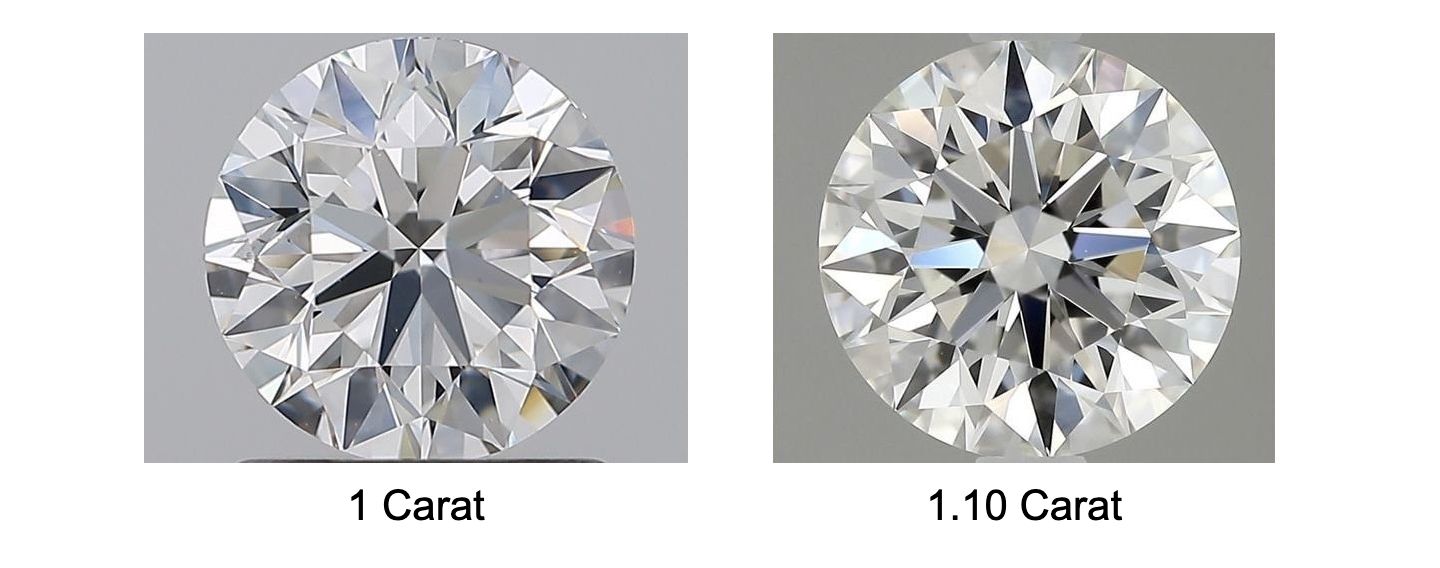
Look at the diagram above. It is a top-down view of two diamonds. One is 1 carat and the other one is 1.1 carat. You can see that the 1-carat diamond looks just as big as the 1.1-carat diamond (it has the same length and width). But how can it be? The answer is revealed when we look at the side profile of the diamonds. There we see that the 1.1-carat diamond is much deeper than the 1-carat diamond and all its weight is hiding down below but is not visible from the top. In this case, we would say that the 1-carat diamond has a visual carat of 1.1. Visually it appears just as big as a 1.1-carat diamond.
You might conclude that you should always get a diamond that looks larger from the top. After all, who cares how deep the diamond is? It will be hidden by the setting anyway. However, we will soon see (when we talk about cut), that the appropriate depth of a diamond is crucial for its sparkle. A diamond that is too shallow will appear lifeless and dead. Therefore, caution must be observed.
In general, however, if both diamonds have ideal cuts (which means they have the best sparkle), you should prefer the diamond that looks larger. At Ritani, we help you see that information at a glance by providing the visual carat weight. The visual carat weight of a diamond is the apparent weight in relation to the average proportioned diamond.
Learn More about Visual Carat
Color
A pure diamond is entirely transparent and appears white. However, pure diamonds don’t exist. All diamonds have tiny impurities in them. Impurities are minerals that give a slight color to the diamond, and some diamonds have more impurities than others. Diamonds that have high levels of nitrogen have a dirty yellowish tinge that is generally considered undesirable unless the diamond is set in a yellow gold setting in which case the color doesn’t matter that much and can sometimes even be desirable.
The GIA grades the color of the diamond from D to Z (it starts at D to differentiate it from older scales that used the letters ABC), with D being the whitest or most colorless diamond and Z being diamonds with light yellow or brown color. The color scale can be further divided into groups, with D-F diamonds being colorless, G-J near colorless, K-M faint yellow, N-R very light yellow, and S-Z light yellow.
Colorless diamonds are rarer and more desirable and therefore more expensive than colored diamonds. However, diamonds that have very high color levels beyond Z are considered fancy colored diamonds and they can be very expensive. Fancy-colored diamonds include yellow diamonds, blue diamonds, red diamonds, and pink diamonds.
When shopping for a diamond, the sweet spot is diamonds in the near-colorless range (G-J). You won’t really see the difference between a colorless diamond and a near colorless diamond and so the money would be better spent on the other 3 Cs.

At Ritani, we don’t sell diamonds beyond L color.
Fluorescence
Some diamonds will emit blue light when viewed in ultraviolet light such as under an ultraviolet lamp. Those diamonds are said to fluoresce. Typically fluorescent diamonds will emit blue light, but some diamonds will have yellow, green or red fluorescence.
Why is it important? Some people believe that fluorescent diamonds will appear hazy or cloudy when in bright sunlight (due to the ultraviolet sun rays), thus negatively affecting the quality of the diamond.
The GIA ranks diamonds' fluorescence by the intensity of the fluorescence. The following five grades are used: none, faint, medium, strong, or very strong. Diamonds that have fluorescence intensities of strong or higher are generally to be avoided. The exception is when buying a faint yellow diamond with a color above I. It is believed that the blue fluorescence can counteract the yellow of the diamond, thus making it look whiter.
The price of a diamond will also be negatively affected by strong fluorescence. The stronger the fluorescence, the cheaper the diamond. Therefore, it's possible to get a good deal on diamonds with high fluorescent intensities.
It is with noting that in studies the GIA conducted, where they displayed multiple diamonds with similar qualities but varying fluorescence, the average person could not detect any difference between those diamonds.
If you do decide to buy a diamond with strong fluorescence, make sure to examine it under different lighting conditions to make sure that you're happy with your purchase. At Ritani, we give you the option to preview your loose diamond or engagement ring for free - learn more here.
Clarity
You're looking at a beautiful diamond when you notice a speck of dust in the center of the diamond. You brush it off, but it's still there. You rub it vigorously. Still nothing. You hold it up a little closer and you realize that it's something deep inside the diamond. You have just found an inclusion: an imperfection within a diamond.
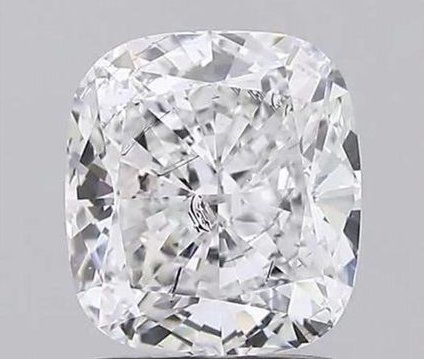
Clarity describes how clear or clean a diamond appears, whether it is flawless or whether it has imperfections. There are two types of imperfections that can occur: blemishes and inclusions.
Blemishes are imperfections on the surface of the diamond. The diamond may be chipped, have scratch marks, or even cracks. Inclusions on the other hand are imperfections inside the diamond. Some inclusions look like white spots, while some appear black and are more noticeable. A cloud is a group of spots that may give the diamond a cloudy look.
When it comes to blemishes and inclusions, size matters. Some imperfections are so tiny that you need a loupe (a small magnifying glass used to view gemstones) to see them, while others are so large that they completely mar the beauty of the diamond.
The GIA uses 6 clarity categories to grade diamonds. Some of those categories are further subdivided for a total of 11 precise grades. Those grades describe the size of the imperfections and whether they are visible to the naked eye or only under 10x magnification with a loupe.
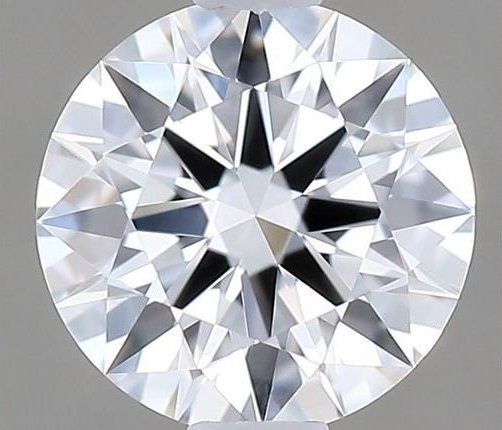
Flawless
Flawless diamonds are the pinnacle of perfection. They have no inclusions or blemishes even when viewed with a loupe.
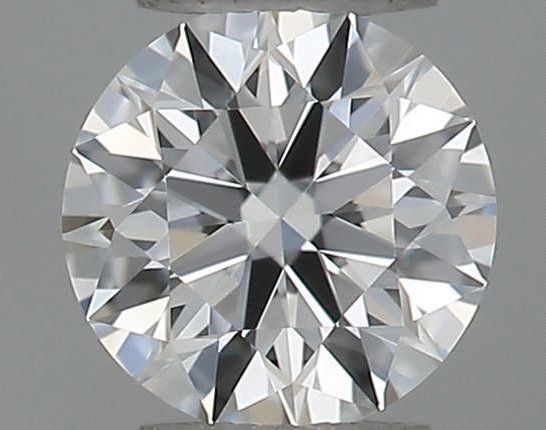
Internally flawless
These diamonds have no inclusions within the diamond (hence they are internally flawless) but they may have slight blemishes on the outside of the diamond when viewed with a loupe.
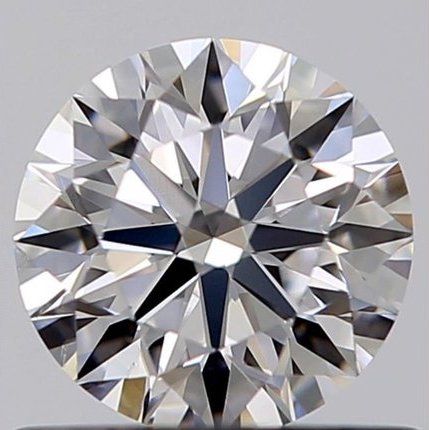

Very Slightly Included (VS1 and VS2)
These diamonds may have inclusions or blemishes that are slightly bigger than the “very, very slightly included” group, but still only visible with a loupe and with some effort.
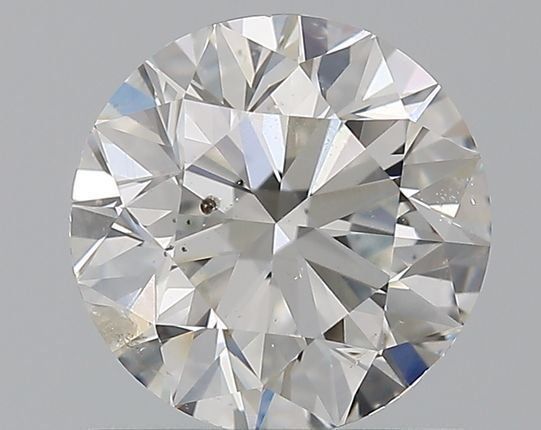
Slightly Included (SI1 and SI2)
These diamonds have inclusions that are noticeable with a loupe and sometimes even with the naked eye. Most SI1 diamonds still appear clean to the naked eye, while SI2 diamonds are borderline eye clean.
Included (I1, I2, and I3)
These diamonds have large imperfections visible to the naked eye and should thus be avoided. At Ritani, we don't sell included diamonds.
Eye Cleanliness
As we just saw, the first six clarity grades describe extremely clean diamonds, with the only difference between them being how much the grader has to strain to see those imperfections with a loupe! For most people, imperfections are only considered a problem if they are visible to the naked eye or if they cause the diamond to appear cloudy. Therefore we are only interested in knowing if the diamond is eye clean.
As a general rule of thumb, most diamonds are considered eye clean until they reach SI2 clarity. SI2 diamonds might still be eye clean, but it depends on the types and placement of the imperfections. Clouds or carbons (which are black spots) in SI2 diamonds are generally bad. Likewise, imperfections that occur in the center of the diamond have a greater negative impact than imperfections that occur on the edges of the diamond.
The shape of a diamond might also affect its eye cleanliness. Step cut diamonds (like emerald and Asscher cut diamonds) have rectangular facets which makes the diamond more transparent and thus the imperfections more noticeable. For those diamonds, a clarity of VS1 or better should be preferred.
At Ritani, we make it easier for you to determine if your diamond is eye clean. For each diamond, we will tell you if it's eye clean, possibly eye clean, or not eye clean. If ever in doubt, consult with one of our trained gemologists to discuss your diamond.
Cut
A diamond's cut describes not its shape, but its proportions, how shallow or deep it is and how its facets are arranged. Because the brilliance and sparkle of a diamond depends on its cut, it has the most important effect on your diamond. After all, who wants a large clean diamond if it appears lifeless and dull?
You might have been led to believe that a diamond sparkles naturally, but this couldn't be further from the truth.
When a diamond is extracted from the earth in its raw form, it is called a rough diamond. Rough diamonds have irregular shapes and appear dull. For years that was the best people could do.
Then people discovered that they could remove the roughness of diamonds and make them more transparent by grinding them with diamond powder. Those improved diamonds had a polished shiny surface but they still didn't sparkle much.
Eventually polishers learned how to cut the irregular surface of the diamond and create a flat surface. Those flat surfaces are called facets. Facets greatly improve the sparkle of diamonds.
Cutters started to experiment with those facets. They made different types of facets and played around with the number of facets. All those changes affected the brilliance of the diamonds and the hunt was on to find the most brilliant diamond.
In 1919, the Belgian gemologist and mathematician, Marcel Tolkowsky, published his PhD thesis where he developed a mathematical model for maximizing the reflected light of a diamond and thus its brilliance. His model called for creating exactly 58 different facets on a round diamond and placing them in exact order with precise angles. Thus the modern round cut diamond was born.
Brilliance, Fire and Scintillation: The mathematics behind the ideal cut
To understand how a diamond is affected by its cut, we need to look at the behavior of light as it enters a diamond. When a ray of light hits a diamond, it will either be reflected and bounce off the surface or it will enter the diamond. When light is reflected off a diamond, it appears as a white flash of light and gives the diamond a bright appearance. The brightness of a diamond is also known as brilliance.
If the light ray enters the diamond at an angle it will refract. refraction is the bending of light as it changes speed. Because light travels slower in a diamond than through the air, it bends as it enters the diamond. This bent ray of light will then continue to travel through the diamond until it hits the other side. At that point if the light hits the other side at the right angle it will be reflected back into the diamond until it exits at the same side it entered, otherwise it will exit the diamond.
This is the key to maximizing a diamond’s brilliance. As Tolkowsky had discovered, if the facets are arranged at the correct angles, it will cause most rays that enter the diamond to be reflected back out and increase the diamond’s brilliance. If however, the facets are incorrectly angled, the light will just exit out of the other side and the diamond will appear duller. Diamonds whose facets are cut at ideal angles, are said to have an ideal cut.
White light is composed of many different wavelengths of light traveling together. Each wavelength of light appears as a different color, such as red, blue or green, however when all wavelengths travel together they appear white. As we previously saw, when light enters a diamond, it slows down. Because each wavelength of light travels at different speeds within the diamond, each wavelength gets bent at a different angle. This causes the white light to separate into its component colors, a process called dispersion. The dispersion of light causes the diamond to emit beautiful flashes of colored light, like the colors of the rainbow, and gives the diamond its fire.
The brilliance and fire of a diamond combine to produce its sparkle. When a diamond is turned in your hand, it will catch light at different angles and sparkle with flashes of white light (brilliance) and colored light (fire). This sparkle is called scintillation.
Hopefully, by now you've realized the importance of the diamond's cut, as changes in the size, number or arrangement of facets can dramatically change the brilliance of the diamond. Likewise the angles of the diamond's facets greatly influence the amount of light it reflects. Diamonds that are too shallow or too deep will leak light through the bottom or the sides and thus affect the brightness of your diamond.
A diamond’s cut is graded by the GIA as Excellent (also known as Ideal), Very Good, Good, Fair or Poor. Because cut is so important to a diamond’s brilliance, you should strive to get a diamond with a cut grade of ideal or very good. At Ritani we don’t sell diamonds with a cut grade of fair or lower.
Polish and symmetry
Two other diamond qualities that also affect the cut of the diamond but are not as important, are polish and symmetry.
Polish refers to the quality of the polished diamond surface. After a diamond is cut, its facets are polished to give them a smooth glassy appearance. Bad polishing can leave scratch marks or nicks on the surface of the diamond, or even leave an irregular rough surface. Just like cut, polish is graded from Excellent to Poor. At Ritani we don’t sell diamonds with a polish grade of fair or lower.
Symmetry refers to the arrangement of the diamond’s different facets. Some diamonds have facets that are misshapen or off center or have uneven corners. Poor symmetry can affect a diamond’s brilliance and sparkle. Just like cut, symmetry is graded from Excellent to Poor. At Ritani we don’t sell diamonds with a symmetry grade of fair or lower.
Diamonds that have excellent cut, excellent polish and excellent symmetry are also known as triple X diamonds and exhibit the best craftsmanship. Keep in mind however, that diamonds with polish or symmetry of good and above will not have any imperfections visible to the naked eye. Therefore, you should not reject a good diamond just because it only has good polish or symmetry.
Diamond Shapes
The first thing you might notice when looking at a diamond is its shape. You are probably already familiar with the round-cut diamond since it’s the most popular shape and very classic. However, diamonds are cut in various other shapes to suit everyone’s taste. Some diamonds are round, some are square. Some are elongated and some have a romantic appeal like the heart-shaped diamond. Unlike the 4Cs, there is no right or wrong shape, it’s up to your taste.
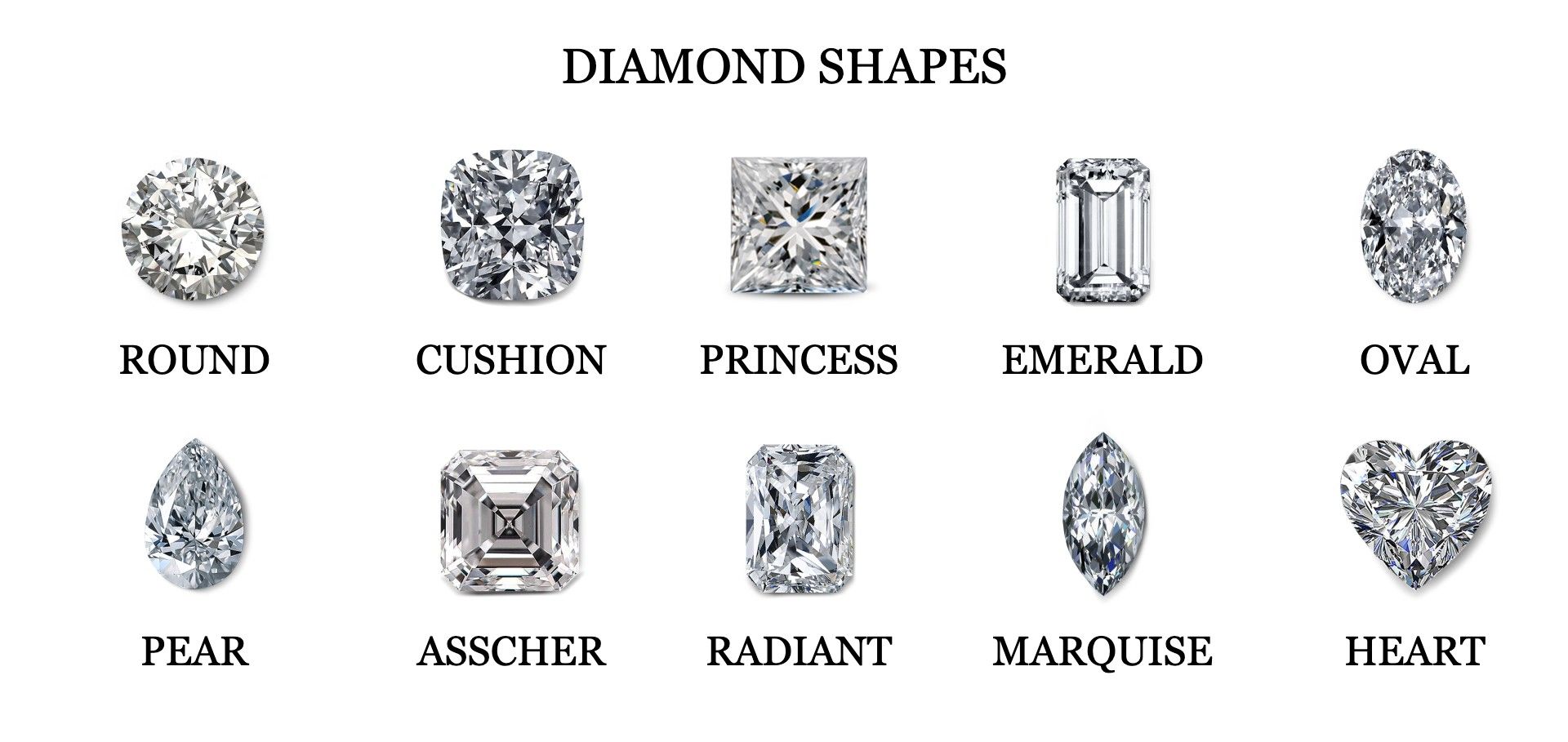
Although diamonds have been cut in various shapes throughout the ages, there are currently 10 modern diamond shapes. They are the round, oval, marquise, emerald, Asscher, cushion, radiant, heart, princess, and pear shapes.
Brilliant cut vs step cut
Diamond shapes can be broadly classified into two cuts: brilliant cuts and step cuts. Brilliant cut diamonds are designed to maximize the diamond's brilliance and sparkle, hence their name. When looking down the table of a brilliant cut diamond, you will notice that you can’t really see through the diamond. You will see a mixture of shapes, like stars, kites, and triangles.
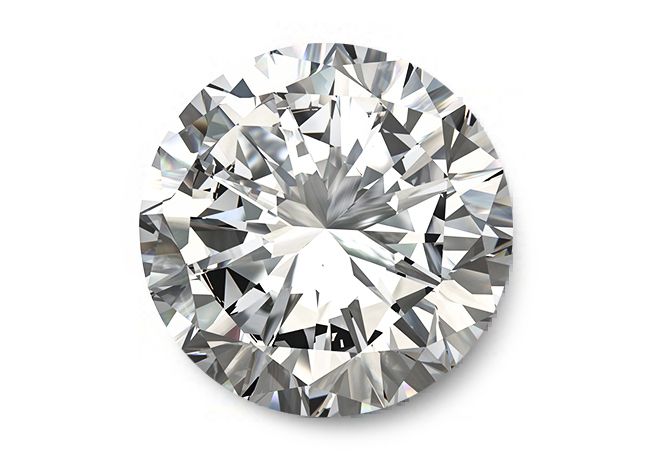
Those shapes are the different shaped facets that surround the diamond. When the diamond is turned, you will see it sparkle in every direction with white and colored light.
Step cut diamonds on the other hand are designed to maximize the clarity of the diamond. They are square or rectangular and have straight parallel facets that start from the table (top of diamond) and go down in steps until the edge of the diamond.
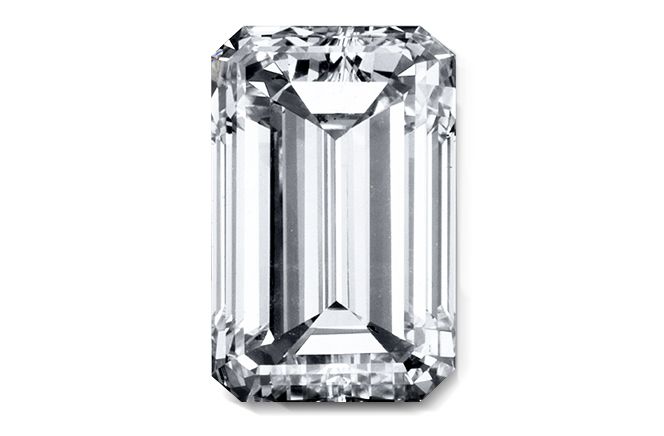
When looking at a step cut diamond, you will notice that the diamond is much more transparent and it produces the hall of mirrors effect where the parallel facets reflect off each other. Step cut diamonds don’t have as much sparkle as brilliant cut diamonds, rather they give off bright flashes of light as they are turned. Because step cut diamonds are more transparent, care must also be taken to select a high clarity grade, since inclusions will be much more noticeable.
Brilliant-Cut Diamonds
Round
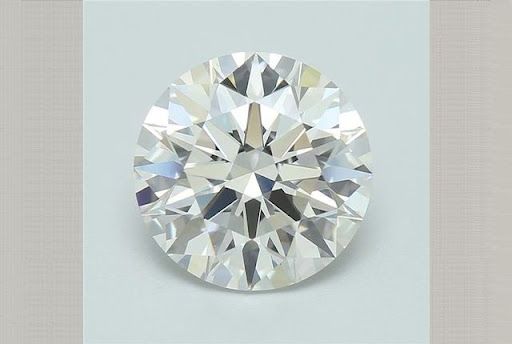
The round diamond is the most popular diamond sold and for good reason. It has a classic look and is one of the most brilliant diamonds there is. If ever in doubt, you can not go wrong by choosing a beautiful round-cut diamond. On GIA reports, the shape of the modern round cut diamond will be described as round brilliant, to distinguish it from its vintage counterpart, the old European cut, which does not have the facet arrangement and thus the sparkle to warrant the name "brilliant". All other non-round diamond shapes are called fancy shapes.
Oval, Marquise, and Pear

Oval, marquise, and pear diamonds are elongated round diamonds and make the finger appear longer and slimmer. Because they are elongated, they also give the illusion of a larger size compared to the round diamond. Oval diamonds are oval as their name implies. Pear-shaped diamonds are oval-shaped on one end and pointed on the other. They are also sometimes called teardrop diamonds. Marquise cut diamonds are pointed on both ends. Because marquise diamonds have a boat-shaped appearance, they are also called navette cut diamonds (the French term for little boat).
Heart
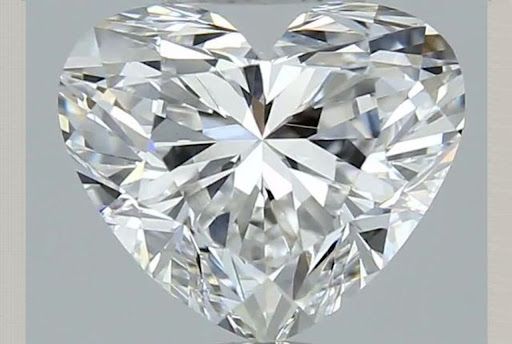
The heart-shaped diamond is the most romantic of all the diamonds and the most unique. As a symbol of love and passion, they make for a romantic gift. It takes great skill to produce a properly cut heart-shaped diamond.
Princess, Cushion, and Radiant

If you are looking for a more square or rectangular look, go with the princess, cushion, or radiant cuts. Princess diamonds are usually square (but sometimes more elongated) and they have sharp pointed edges. The GIA calls them “square modified brilliant” diamonds. Cushion-cut diamonds can be square or rectangular but they have soft rounded edges and thus look like a cushion. Radiant cut diamonds are usually rectangular and their edges are beveled and cut at an angle. On GIA reports, they will usually be listed as “cut-cornered rectangular modified brilliant”.
Step-Cut Diamonds
Emerald and Asscher

Emerald cut diamonds are rectangular step cut diamonds with cut corners. They are similar to the radiant cut, but while the radiant is a brilliant cut diamond, the emerald is a step cut diamond. Asscher diamonds look like emerald cut diamonds but are square-shaped. Their edges are usually cut more deeply than their emerald counterparts which combined with their square shape gives them an octagonal appearance.
The Anatomy of a Diamond
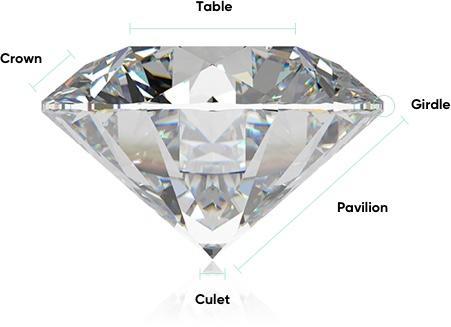
When reading about a diamond, you will encounter new terminology referring to certain parts of the diamond. Here we will explore the different parts of the diamond and how they can affect the quality of your diamond.
If you look at a round diamond’s side view, you will notice it has two distinct parts. The top of the diamond is known as the crown and the bottom of the diamond is the pavilion. Between the crown and the pavilion is a thin band going all around the diamond, known as the girdle. The girdle surrounds the widest part of the diamond and is there to protect it from chipping since pointed edges are prone to chipping.
Table
If you look at a round diamond’s top view, you will see a large facet (flat surface) in the center of the diamond. This is the largest facet of a diamond and is known as the table. The table has the very important function of gathering light and reflecting it back. The size of the table can be expressed both as a number (such as 5mm) or as a percentage of the diamond's diameter (such as 50%). Most round-cut diamonds today have table sizes between 50-66 percent. A very small or very large table will negatively affect the diamond and will be reflected in a lower cut grade.
Crown
The top half of the diamond is known as the crown. In the center of the crown lies the table. As you move away from the table, the diamond starts sloping down towards the girdle. There are multiple facets between the table and the girdle (32 in a round cut diamond) and they contribute to the dispersion of light. The angle that the crown facets make with the girdle is known as the crown angle and is usually between 25% and 35%.
Girdle
The widest part of the diamond is known as the girdle. The thickness of the girdle is expressed as a percentage of the diamond’s diameter (such as 4%) or using words (thin, medium, thick). Because of the way the facets of the crown and pavilion meet in a round diamond, the girdle’s thickness will not be even and is usually described as a range (such as thin - medium). A very thick girdle might make a diamond look darker, while a very thin girdle could make the diamond prone to chipping.
A diamond’s girdle can be unpolished (also called a bruted girdle) in which case it will have a frosty appearance, or it could be polished and have a smooth surface. Faceted girdles will have a series of small facets all around it.
Pavilion
The bottom half of the diamond is known as the pavilion and it has many facets around it (24 for a round diamond). The angle the pavilion facets make with the girdle is called the pavilion angle. A proper pavilion angle is also important for an ideally cut diamond.
Culet
The bottom part of the diamond is known as the culet. It is a small facet designed to protect the bottom of the diamond from chipping and abrasions. The culet thickness will be described in words (thin, thick, etc). Many diamonds don’t have a culet at all. In that case, the culet description will say “none” or “pointed” since the diamond just ends in a point.
Diamond Types: What is a Diamond and How is it Made
A diamond is made entirely out of carbon. But you might be surprised to learn that the graphite in your lead pencil is also made entirely out of carbon. So how is it possible for them to appear so different? One is extremely soft and the other is the hardest mineral on the planet. One appears gray and dull, and the other is transparent and produces immense sparkle.
The answer to this question lies in the structure of those materials. In graphite, the carbon atoms are layered in sheets, while in a diamond the carbon atoms form a crystalline tetrahedral structure where each carbon atom is attached to four neighboring carbon atoms. This difference in structure is responsible for the differences in their observed qualities.
So how do you take regular carbon atoms and arrange them into crystals? The answer is high pressure and high heat. When carbon atoms are subjected to high pressure and high heat, they rearrange and form a crystalline lattice. There are two processes that can cause this. One is natural, the other is artificial.
Earth Grown (natural) Diamonds
When carbon deposits get buried deep beneath the earth’s surface, they are subjected to high pressure and high temperature. Over the course of hundreds of millions or billions of years, the carbon atoms are transformed into diamonds. Some of those diamonds then get pushed closer to the surface where they can be found.
To access those diamond deposits, mines are usually dug a few hundred feet down into the earth’s surface. The rough diamonds are then extracted and processed. Because of the rarity of natural diamonds and the work that goes into extracting them, natural diamonds can be very expensive.
Lab Grown (artificial) Diamonds
In recent years, scientists have made great advances in creating diamonds in the lab, so much so that lab-created diamonds are now cheaper than natural diamonds, up to 50% cheaper!
Lab-grown diamonds are not fake diamonds. They are chemically, physically, and optically identical to natural diamonds. Even a trained gemologist cannot discern any difference, since they are created in the same way that natural diamonds are created, under high pressure and high heat.
So which one should you get? Natural or lab? As with diamond shapes, there are no right or wrong answers. It boils down to your preference. Natural diamonds have a rarity factor and some people associate them with the “real thing”. Additionally, their value is based on scarcity and generally holds steady over the years. Lab diamonds are much cheaper than their natural counterparts, however, their resale value might decrease as more and more lab diamonds are created.
Diamond Certification
Now that you know all there is to know about a diamond, and how a change of one grade in clarity can increase a diamond’s value by a lot, what’s to stop an unscrupulous vendor from advertising a VS2 diamond as a VS1 diamond? The answer is nothing. Since vendors have a vested interest in making the most money out of their diamonds, they cannot be trusted. What we need is a third-party company to grade those diamonds.
Vendors will send a diamond to a diamond grading agency which will then have an unbiased trained gemologist grade the diamond. The grading agency will then give the vendor a diamond certificate to prove that the diamond was graded correctly. The certificate will also be published on the vendor’s website so anyone can verify its authenticity. Many certified diamonds will also have a laser inscription on the diamond with their certificate number so that you can verify that your diamond belongs to that certificate number. You should always buy certified diamonds and make sure to check your diamond certificate to verify its grading. At Ritani we only sell certified diamonds.
There are many diamond grading labs. Some have higher standards and some have lower. The GIA is the most popular grading lab with the highest grading standards. At Ritani we only sell natural diamonds that have GIA or AGS certification. For lab diamonds, the GIA has only recently begun to make certificates, so we rely on IGI for the majority of our lab-grown diamonds. Some other reputable lab grading agencies you might see on our site are HRD, GCAL and DF.
How to read a lab diamond report
When looking at a GIA report, you will typically see three columns. The rightmost column will contain the grading scales that GIA employs for cut, color and clarity so you don’t have to remember them. The first column will contain the certificate number, the date it was graded and the grading values for all the diamond qualities. The center column will usually contain two diagrams: the proportions diagram and the clarity characteristics diagram.
The proportions diagram will list all the diamond proportions like the table size, crown and pavilion angles, and depth percentage. The clarity characteristics diagram is very important as it will list all the inclusions and blemishes of your diamond (if it has any) and mark where they occur.
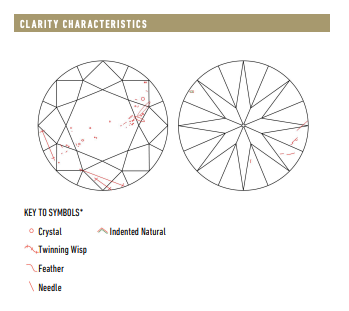
While a diamond might have a grade of SI1, it doesn’t tell you what type of inclusions it has (some are worse than others) and it doesn’t tell you if it occurs smack dab in the center or right near the edge. The clarity characteristics diagram will use different symbols and marks on a diamond figure to show you where imperfections occur. The key to symbols will tell you what each symbol means.
Familiarize yourself with the GIA grading report
Familiarize yourself with the IGI grading report
Summary
When buying a diamond, first decide on the shape and whether you would like a natural diamond or lab diamond. After that, start focusing on the 4 Cs.
Cut is the most important of the 4 Cs as it affects your diamond’s sparkle. Try to get an ideal or very good cut as they have the most sparkle. For color, aim for a grade in the G-J range and they will appear colorless to you. When it comes to clarity, look for an eye clean diamond. For brilliant cut diamonds, that usually means getting a diamond clarity of SI1 or above, but sometimes even SI2 diamonds are eye clean. For step cut diamonds, aim for VS1 or above. If in doubt consult with one of our trained gemologists. The rest of your budget should go towards the carat weight.
Keep in mind however, that the above guidelines are just that - guidelines. If you find a L color SI2 diamond that looks perfect to you, don’t be afraid to get it. After all, beauty is in the eye of the beholder. Make sure that your diamond looks perfect to you and not on paper. Make use of our high definition pictures and videos to see your diamond’s minute details and to appreciate its sparkle.
Now that diamonds have been demystified for you, head over to view our vast collection of beautiful natural and lab grown diamonds and make your educated pick. Diamond shopping is fun and the result is rewarding. Enjoy!
